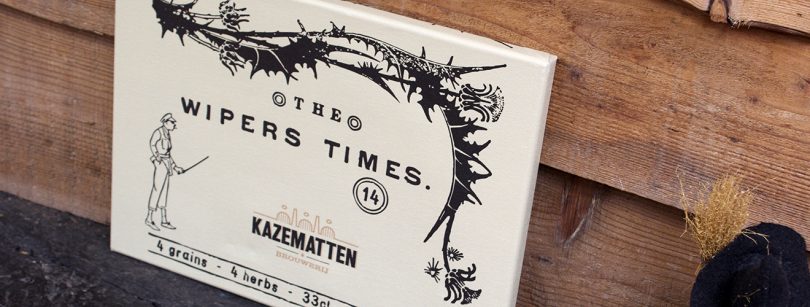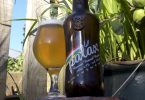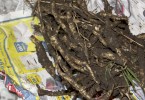Every February we make our way down to the Truman Brewery in London to attend Craft Beer Rising where, along with sampling some of the best modern beers around, we also hold talks about home grown or foraged beer.
This year Rich had to make an unscheduled trip to Leicestershire instead, meaning that I would have to run our session solo. Without Rich’s jokes to back me up how could I possibly keep the punters entertained while attempting to educate them with my foraged beer ramblings? Fortunately we stocked up with booze samples containing some of the featured ingredients and, although many of them were stuck with Rich in the East Midlands, I had just enough to distract the audience with regular sippings of free beer.
One of the beers we included was Tomos a Lilford’s stout Crwrgl, which is brewed with two varieties of seaweed. You can find more about this fine drop in a blog about our trip to the brewery, here. The other three beers – craftily prized from our pals at Beer Hawk – each use ingredients with equally interesting stories to tell, so here are short versions of each of those tales…

To Øl, Frost Bite, 6%
Foraged ingredient: pine
Spruce and pine are among our favourite forageable ingredients. We’ve written about them in the past, including how you can use them to infuse vodka or even pickle the tips for a cheap woodland snack. Those vivid green young spruce tips have an interesting slot in the history of brewing: such is their high content of vitamin C, Captain Cook served a beer made from molasses and spruce tips to help his crew fend of scurvy.
Although far from common, there has been a steady trickle of beers produced using pine or spruce in recent years. Scotland’s Williams Brothers make an excellent Christmas ale called Nollaig which has been spruced up with the flavoursome needles, but for our demo we turned to Denmark’s To Øl for a wintery American Pale Ale called Frost Bite. Many modern American hops have aromas and flavours that taste of pine and orange, so To Øl picked out a hop combination that would give their beer this profile (Aurora, Citra, Tettnanger, Simcoe and Amarillo) and then doubled the effect by adding actual pine needles and orange peel.
The result is an invigoratingly fresh and zesty affair, with the pine flavours subtly through the crisp, frosty ale.

HaandBryggeriet, Norwegian Wood, 6.5%
Foraged ingredient: juniper
Our next beer is another Scandinavian effort, this time from the outstanding Norwegian brewery HandBryggereit. The brewery’s commercial description of Norwegian Wood includes the historical inspiration behind the beer: “Once, every farm in Norway was required by law to brew its own ale. All of that ale had a natural smoky taste because the malt was kilned by fire, and most of it was spiced with juniper berries.” Neighbouring Finland is also well known for a beer style that relied on juniper – Sahti uses the branches of the plant as a flavouring and beer-making tool, with the mixed-grain brew being filtered through a trough lined with juniper twigs.
We’re such big fans of juniper as a beer ingredient we even managed to create a home brew recipe for a juniper rye ale which features in our book, Brew it Yourself. But for anyone wishing to taste juniper in beer-action without having to brew their own, HandBryggereit’s is well worth trying. To stay true to their local inspiration it’s a smoked ale, although the smokey grain flavours don’t dominate as they do in other smoked beers. It has a lovely sweet toasted grain backbone and quite mix of herby, citrussy and spicy flavours dancing on the tongue, with some mature woody notes and a lovely dry finish.
Brouwerij de Kazematten, The Wipers Times 14, 6.2%
Foraged ingredient: blessed thistle seeds
Last year I visited Brouwerij de Kazematten in the Belgian city of Ypres. The local tourist board is keen to promote the area for its beer heritage, along with its more well known association with the first world war, and the brewery – established with the support of the city council – is a destination that covers both subjects. It’s housed within the 17th century fortified wall that surrounds the city and its flagship beer, The Wipers Times 14, is named after the trench gazette that was produced in the same location (‘Wipers’ being the soldiers nickname for Ypres).
To further the links with the paper’s history and locality, this blond beer is brewed with local hops and four herbs, including seeds from the blessed thistle, an illustration of which forms part of the old Wipers Times masthead and the new bottle label. Brewery founder Rudy Ghequire, also a brewer at Rodenbach, wouldn’t reveal the other herb additions and was very cagey when I asked how he worked out what quantities of blessed thistle to use, responding simply “because I am a brewing expert.” But as with many botanical additions, you’re not necessarily looking to impart the exact flavours of those ingredients into the finished beer but instead alter the taste and texture of the overall brew to create something unique.
So The Wipers Times 14, while being typical of Belgian blonde ales in many ways, also possesses complex herby and grainy flavours, a slightly sweet and creamy body and some delicate soft fruit aromas.








